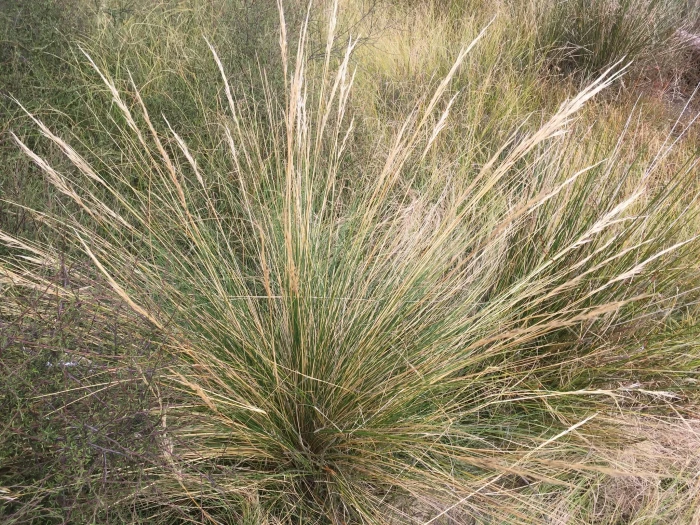Prickly Spear-Grass
(Austrostipa stipoides)
Prickly Spear-Grass (Austrostipa stipoides)
/
/

nick_goldwater
CC BY 4.0
Image By:
nick_goldwater
Recorded By:
Copyright:
CC BY 4.0
Copyright Notice:
Photo by: nick_goldwater | License Type: CC BY 4.0 | License URL: http://creativecommons.org/licenses/by/4.0/ | Rights Holder: nick_goldwater | Publisher: iNaturalist | Date Created: 2019-12-26T04:27:10Z |

























Estimated Native Range
Climate Requirements for Pickerington, Ohio
| This Plant | Your Site | Plant Suitability for Your Location | ||
|---|---|---|---|---|
| • Precipitation | 12" - 87" | 38" | Aquatic | Aquatic |
| • High Temp. | 63°F - 88°F | 85°F | Your summer temperatures are normal for this plant. | Excellent |
| • Low Temp. | 29°F - 53°F | 19°F | Your winter temperatures may be too cold for this plant | Too cold |
This plant may not grow well at your location - your precipitation is too high.
Summary
Austrostipa stipoides, commonly known as Prickly Spear-grass or Coast Spear-grass, is a perennial grass native to coastal regions of southeastern Australia and New Zealand. It typically forms large, dense tussocks reaching up to 31 inches in height. The leaves are inrolled, smooth, and can be up to 28 inches long and 0.04 inches wide, ending in sharp tips that may deter herbivores. The inflorescences are slender and can extend above the foliage, bearing feathery spikelets that are wind-pollinated. Flowering occurs mainly in spring and summer, and the flowers are not particularly showy but have a subtle beauty in their structure.
Prickly Spear-grass is valued for its ability to stabilize sandy soils and is often used in coastal revegetation projects. It is highly tolerant of saline conditions, making it suitable for planting in challenging coastal environments. In cultivation, it requires well-drained soils, can withstand full sun to part shade, and is drought-tolerant once established. While it is not commonly used in ornamental gardening, its resilience and ecological role in habitat restoration make it a significant species for conservation efforts. Gardeners should be aware that the sharp leaf tips can be a nuisance if the grass is planted in areas with foot traffic.CC BY-SA 4.0
Prickly Spear-grass is valued for its ability to stabilize sandy soils and is often used in coastal revegetation projects. It is highly tolerant of saline conditions, making it suitable for planting in challenging coastal environments. In cultivation, it requires well-drained soils, can withstand full sun to part shade, and is drought-tolerant once established. While it is not commonly used in ornamental gardening, its resilience and ecological role in habitat restoration make it a significant species for conservation efforts. Gardeners should be aware that the sharp leaf tips can be a nuisance if the grass is planted in areas with foot traffic.CC BY-SA 4.0
Plant Description
- Plant Type: Grass
- Height: 1.5-2.5 feet
- Width: 1.5-2.5 feet
- Growth Rate: Moderate
- Flower Color: N/A
- Flowering Season: Spring, Summer
- Leaf Retention: Evergreen
Growth Requirements
- Sun: Full Sun, Part Shade
- Water: Low, Medium
- Drainage: Medium, Fast
Common Uses
Bird Garden, Drought Tolerant, Erosion Control, Groundcover, Low Maintenance, Street Planting
Natural Habitat
Coastal regions of southeastern Australia and New Zealand
Other Names
Common Names: Coastal Spear Grass
Scientific Names: Austrostipa stipoides, Achnatherum stipioides, Dichelachne stipoides, Stipa stipoides, Stipa teretifolia
GBIF Accepted Name: Austrostipa stipoides